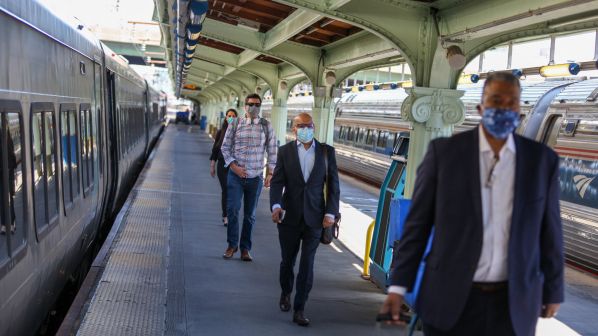In an October 8 letter to vice-president, Mr Michael Pence, in his capacity as Senate president, and House speaker, Ms Nancy Pelosi, Amtrak president and CEO, Mr William J Flynn, formalised the $US 4.857bn funding request.
“We have seen that our ridership is not returning as quickly or at the levels that we had hoped for,” Flynn wrote.
According to Amtrak, business remains at about 25% of pre-Covid levels, and fiscal year 2021 ridership and revenue are forecast to improve to about 40% of pre-Covid levels, which is “weaker than anticipated.”
The requested funds would be allocated as follows:
• $US 3.227bn to preserve Amtrak’s services and capital programme in response to the dramatic loss of revenue due to the pandemic. Of that figure, $US 1.704bn would be used for the Northeast Corridor (NEC), $US 413m for Amtrak’s share of State Supported services, and $US 1.11bn for Long Distance services, and
• $US 1.63bn to “support Amtrak RRIF/debt payments, state and commuter partner payments that are payable to Amtrak under PRIIA Sections 209 and 212, the costs of any congressional workforce or service directives, and added revenue risk beyond our current projection.”
“If we received this funding, we would be able to operate train services and invest in capital projects,” Flynn explained in a recent message to employees. “This means we would restore Long Distance service to seven days a week as we operated in fiscal 2020. Furloughs associated with these lower service levels would be reversed. We anticipate that our state partners would have the resources they need to continue state-supported routes.”
He also recommended in his letter to Congress that the $US 5.193bn in additional need “be included as part of any economic recovery proposal enacted by Congress before the end of the term to help the nation recover from the impacts of the pandemic.”
The $US 5.193bn includes:
• $US 642m for fleet replacement (Amfleet and Superliner)
• $US 1.242bn for NEC infrastructure (Hudson Tunnel Project, Portal North Br., Sawtooth Bridge, East River Tunnel, B&P Tunnel, Susquehanna River Bridge, Pelham Bay Bridge, Connecticut River Bridge)
• $US 1.893bn for national network infrastructure (Southeast Corridor Expansion, Gulf Coast, Southwest Chief, Chicago Gateway, and new and expanded routes)
• $US 809m for major stations (Chicago, Philadelphia, New York Penn, Baltimore Penn, Washington Union and others), and ADA compliance/improvements, and
• $US 607m for other key initiatives (PTC and safety improvements, workforce development and apprenticeship, and RRIF and other debt payments).
“When considered in their totality, our fiscal year 2021 needs and our economic recovery proposal equal a total federal investment of $US 10.05bn, an amount equivalent to the total appropriation for Amtrak included in the House of Representatives’ FY 21 Transportation, Housing and Urban Development, and Related Agencies Appropriations bill (H.R. 7616),” Flynn wrote.
“These funding needs have been shared in detail with the House and Senate Appropriations and relevant authorising committees during recent months. Such funding could be provided in the annual appropriations bill, as part of a Covid-19 relief bill, in an economic stimulus bill, or via any other legislative vehicle.”
While Congress on September 30 passed a continuing resolution (CR) to provide Amtrak funding at the FY 2020 rate of $US 2bn until December 11, and the House on October 1 passed an updated version of the Heroes Act, including $US 2.4bn in emergency supplemental funds for Amtrak, there is “no clear path to finalise such supplemental funding in Congress and the Administration,” Flynn wrote.
Given these factors and Amtrak’s low levels of ridership and revenue projected over the next few months, Flynn says that “Amtrak is in a very precarious position as we await final decisions on our funding levels.”
“To manage this situation, Amtrak will work to adjust its operating and capital spending plans during this short-term CR, with the aim of minimising further impacts on our customers and employees. However, if the FY 20 funding level is extended beyond December 11, 2020, and supplemental funding has not yet been provided, we will be unable to avoid more drastic impacts that could have long lasting effects on our NEC infrastructure and the national rail system.
“For example, insufficient funding levels could force Amtrak to reduce its workforce by an additional 2400 jobs as we scale back capital projects (approximately 775 jobs) and because our state partners have advised us that they would likely further reduce their train service (approximately 1625 jobs).”

